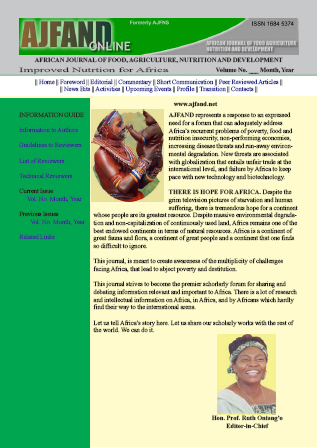
|
African Journal of Food, Agriculture, Nutrition and Development
Rural Outreach Program
ISSN: 1684-5358
EISSN: 1684-5358
Vol. 18, No. 1, 2018, pp. 13202-13225
|
 Bioline Code: nd18023
Bioline Code: nd18023
Full paper language: English
Document type: Research Article
Document available free of charge
|
|
|
African Journal of Food, Agriculture, Nutrition and Development, Vol. 18, No. 1, 2018, pp. 13202-13225
| en |
DESCRIPTIVE SENSORY QUALITY OF KENYA’S INDIGENOUS CHICKEN MEAT FROM DIFFERENT ECOTYPE- CLUSTERS REARED UNDER AN INTENSIVE SYSTEM
Oloo, BO; Mahungu, S & Kahi, A
Abstract
Indigenous chicken (IC) in Kenya performs a major food security and socio-economic
function for most households, especially of the rural poor. The trend has been to move
from rearing IC on free-range systems to more intensive and semi intensive systems. This
study was conducted by use of Quantitative Descriptive Analysis (QDA) and the Just
About Right (JAR) scale scores to quantify the appeal of the IC meat reared under
intensive systems. The IC used in the study had been obtained from Taita, Kakamega
and Narok ecotype clusters kept under the intensive system at Indigenous Chicken
Improvement Programme (INCIP) unit at Egerton University. During the intensive
rearing, the chickens were given the same treatment in terms of feed, disease control at
all the stages and water was given ad-libitum. The chickens were slaughtered at the same
age and only cocks were used as control for sensorial differences accruing due to sex.
Five cocks from each ecotype cluster were slaughtered after a feed withdrawal period of
8-10 hours and their meat prepared by boiling for sensory evaluation after ageing on ice
for 3-6 hours. A trained panel of tasters (13-15) was used to evaluate the descriptive and
JAR sensorial quality of indigenous chickens’ meat from the breast and thighs. One
commercial broiler (Kenbro) was used as a control. Results showed that there was
significant effect at P<0.05 of the ecotype of the IC on its meat aroma, flavour and brown
colour intensity. The JAR scale showed that the consumers’ scores for the colour,
flavour, juiciness, tenderness of indigenous chicken was ‘just about right’ compared to
broiler which was described by colour as too light, flavour too strong, too juicy in terms
of expression of juiciness and too tender with regard to texture. The Principal Component
Analysis results showed that there were two principal components (colour and texture)
that accounted for 55.4 % and 11.6% and 53.9 and 19% for both descriptive scores and
JAR scores for IC meat, respectively. This study indicates sensorial differences among
the Kenyan Indigenous chicken ecotypes (of different genetic characteristics) under
intensive systems and demonstrates significant difference among various attributes from
the commercial broiler.
Keywords
Descriptive; sensory evaluation; Kenyan Indigenous chicken; ecotype cluster; intensive system
|
| |
© Copyright 2018 - African Journal of Food, Agriculture, Nutrition and Development
Alternative site location: http://www.ajfand.net/
|
|
